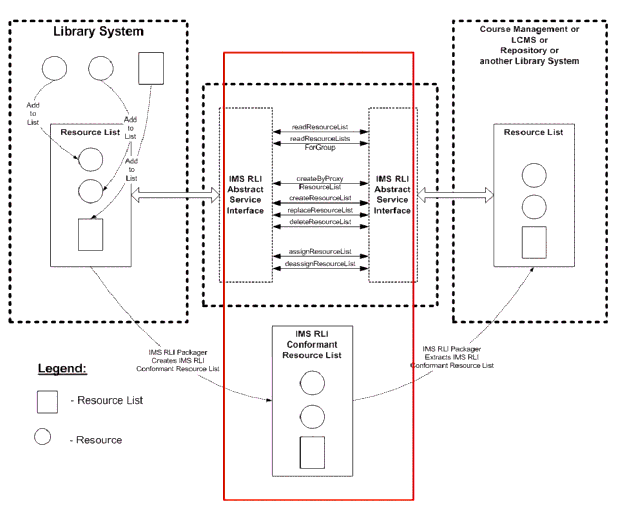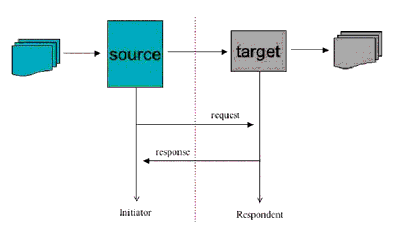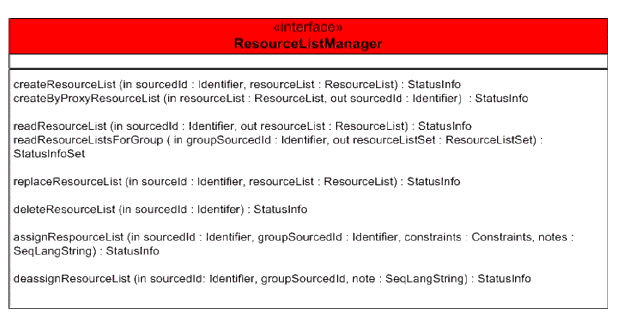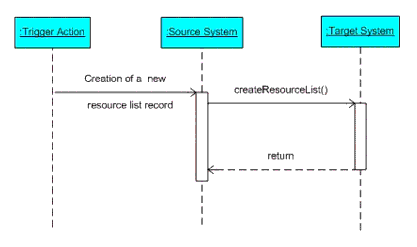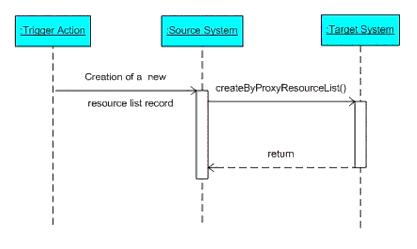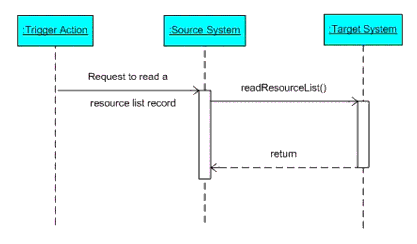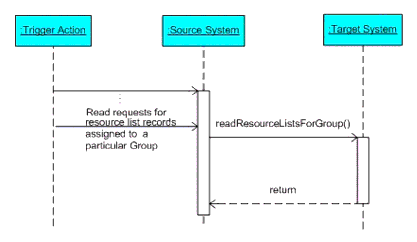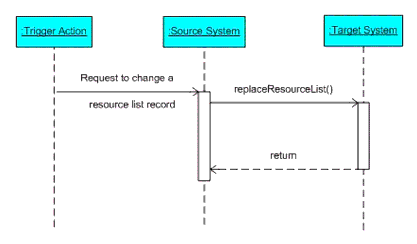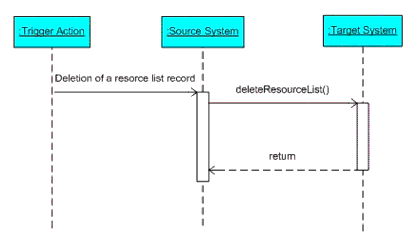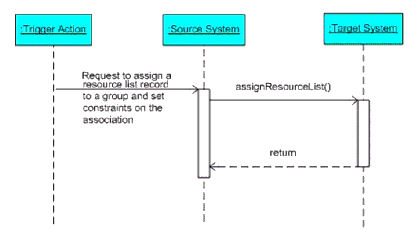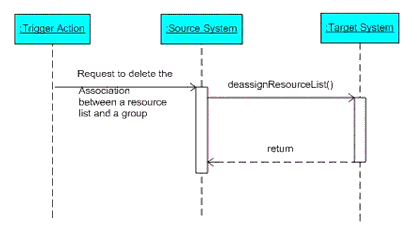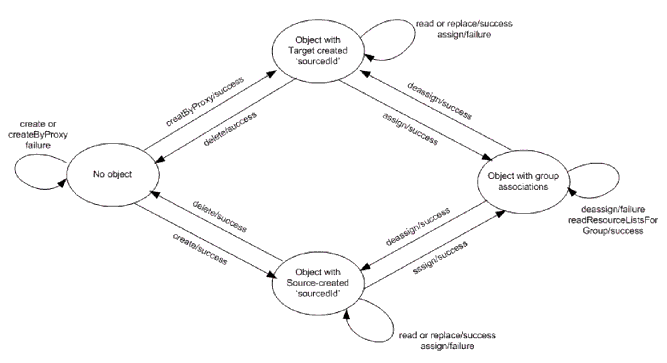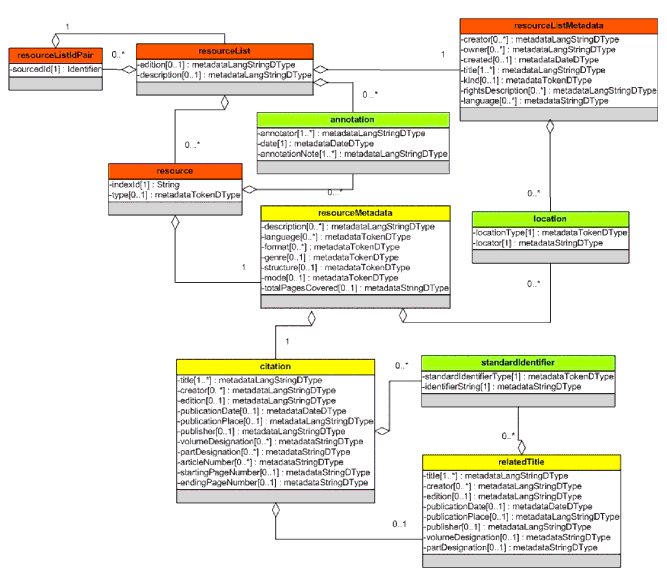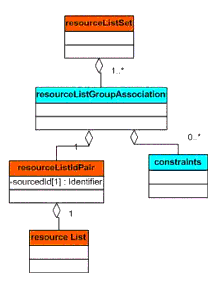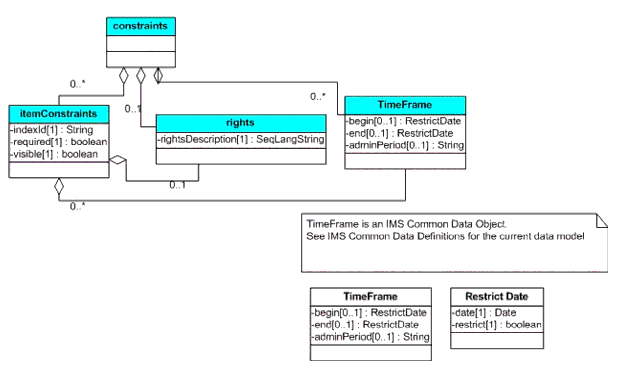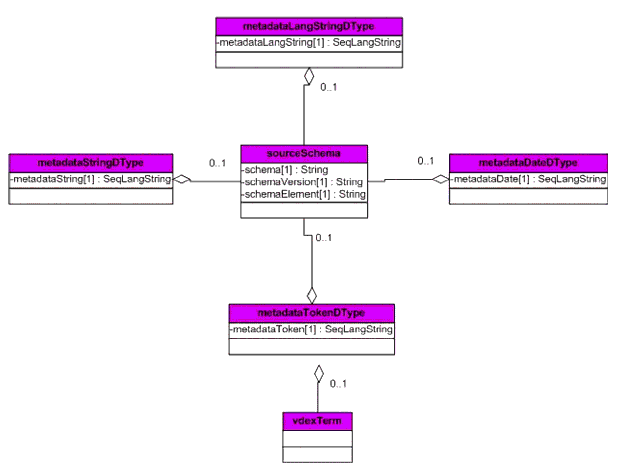 |
IMS Resource List Interoperability
Information Model
Version 1.0 Final Specification
|
Copyright © 2004 IMS Global Learning
Consortium, Inc. All Rights Reserved.
The IMS Logo is a trademark of IMS Global Learning Consortium,
Inc.
Document Name: IMS Resource List Interoperability Information
Model
Revision: 8 July 2004
IPR and Distribution Notices
Recipients of this document are requested to submit, with their comments, notification of any relevant patent claims or other intellectual property rights of which they may be aware that might be infringed by any implementation of the specification set forth in this document, and to provide supporting documentation.
IMS takes no position regarding the validity or scope of any intellectual property or other rights that might be claimed to pertain to the implementation or use of the technology described in this document or the extent to which any license under such rights might or might not be available; neither does it represent that it has made any effort to identify any such rights. Information on IMS's procedures with respect to rights in IMS specifications can be found at the IMS Intellectual Property Rights web page: http://www.imsglobal.org/ipr/imsipr_policyFinal.pdf.
Copyright © 2004 IMS Global Learning Consortium. All Rights Reserved.
If you wish to copy or distribute this document, you must complete a valid Registered User license registration with IMS and receive an email from IMS granting the license to distribute the specification. To register, follow the instructions on the IMS website: http://www.imsglobal.org/specificationdownload.cfm.
This document may be copied and furnished to others by Registered Users who have registered on the IMS website provided that the above copyright notice and this paragraph are included on all such copies. However, this document itself may not be modified in any way, such as by removing the copyright notice or references to IMS, except as needed for the purpose of developing IMS specifications, under the auspices of a chartered IMS project group.
Use of this specification to develop products or services is governed by the license with IMS found on the IMS website: http://www.imsglobal.org/license.html.
The limited permissions granted above are perpetual and will not be revoked by IMS or its successors or assigns.
THIS SPECIFICATION IS BEING OFFERED WITHOUT ANY WARRANTY WHATSOEVER, AND IN PARTICULAR, ANY WARRANTY OF NONINFRINGEMENT IS EXPRESSLY DISCLAIMED. ANY USE OF THIS SPECIFICATION SHALL BE MADE ENTIRELY AT THE IMPLEMENTER'S OWN RISK, AND NEITHER THE CONSORTIUM, NOR ANY OF ITS MEMBERS OR SUBMITTERS, SHALL HAVE ANY LIABILITY WHATSOEVER TO ANY IMPLEMENTER OR THIRD PARTY FOR ANY DAMAGES OF ANY NATURE WHATSOEVER, DIRECTLY OR INDIRECTLY, ARISING FROM THE USE OF THIS SPECIFICATION.
Table of Contents
1.
Introduction
1.1 Specification Overview
1.1.1
Rationale
1.1.2
Background and History
1.2 Components of the
Specification
1.2.1 RLI
Information Model
1.2.2 RLI
Binding
1.2.3 RLI Best
Practice and Implementation Guide
1.2.4 RLI
Conformance Requirements
1.3 Scope
1.4 Structure of this Document
1.5 Nomenclature
1.6 References
2.
Resource List Manager Service Description
2.1 An Abstract Representation
2.2 Resource List Manager Service
Architecture Model
2.3 Resource List Objects
2.4 Synchronous Services
3.
Behavioral Model
3.1 Service Definition - Resource
List Manager Interface Class
Description
3.1.1
Structure
3.1.2
Operations
3.2 Permitted State Sequence
4.
RLI Data Model
4.1 resourceList
4.1.1
Attributes
4.1.2
Associations
4.1.3
resourceListIDPair
4.2 resource
4.2.1
Associations
4.3 annotation
4.4 location
4.5 resourceListSet
4.5.1
Description
4.5.2
Attributes
4.5.3
Associations
4.6 constraints
4.6.1
Description
4.6.2
Attributes
4.6.3
Associations
4.6.4
itemConstraints
4.7 Data Types
4.7.1
Description
4.7.2
sourceSchema
4.7.3
MetadataStringDType
4.7.4
MetadataLangStringDType
4.7.5
MetadataDateDType
4.7.6
MetadataTokenDType
4.8 OCL Definitions
5.
Extending the Service
5.1 Proprietary Extensions
5.1.1
Proprietary Operations
5.1.2
Proprietary Data Elements
5.2 Further Work
Appendix A - Common Components
Appendix B - Service Status
Codes
B1 - Summary List of Codes
B2 - Explanation of Operation
Specific Codes
Appendix C - Sources of Input
Appendix D - Comparison of
Descriptive Meta-data Schemes for Citation
and Resolution
About This Document
List of Contributors
Revision History
Index
1. Introduction
This section is not normative.
1.1 Specification Overview
The Resource List Interoperability (RLI)
specification details how structured meta-data can be exchanged
between systems that store and expose resources for the purpose
of creating resource lists and those that gather and organize
those resource lists for educational or training purposes. A
typical example of such a resource list is a reading list.
The specification is based on an
abstract service behaviors and data model that describes in
generalized terms a resource at the item level, a collection of
these resources (i.e., a list) and the behaviors associated with
a resource list management service. The data model is then bound
or expressed in XML, combining elements that map to subsets of
key standards, including the IEEE-LOM (Learning Object Metadata),
ISO 690-2 for bibliographic citations, and NISO's OpenURL to
describe the resource items and aggregated resource list. The
abstract service interface is bound to web services expressed as
WSDL. The IMS Content Packaging specification wraps the resource
list to enable transfer between systems. Because the data model
is generalized, other bindings may be (and it is expected, will
be) added to future releases of the specification.
The IMS Learning Resource Meta-data
specification (now the IEEE-1484.12.1 LOM standard) was developed
to provide item-level descriptions for the range of instructional
materials that might be used in a virtual learning environment or
course management system, from simple static HTML content to
technically sophisticated simulations. While the LOM anticipates
a broad economy of complex, self-contained e-learning objects, in
the higher education realm much of the digital course "content"
often categorized loosely as "course resources" parallels fairly
traditional collections of supplementary course reading
materials. These course resource lists frequently include links
to freely available content on the Web and other materials that
may not have been formally published, and may also include
bibliographic records from OPACs (Online Public Access Catalog)
and content licensed by academic libraries from publishers and
aggregators.
Naturally, course reserves or
course-specific collections of resources have long been and
continue to be maintained and organized within academic
libraries. The intersection of the library reserves function and
the Web as a content distribution mechanism has given rise to the
notion of "e-reserves." Integrated Library System (ILS) vendors
have developed web-based software tool suites that integrate
OPAC, e-reserves, federated searching and personal bibliographic
management capabilities. At the same time, e-learning systems
provide another logical context and dissemination point for
course-specific collections of resources.
Course Resource Lists, then, may be
maintained in both library and course management systems. Yet,
while instructors are able to add citations and links to readings
or post other supplementary resources directly into the course
environment, they usually do so in an ad hoc fashion not much
different from the manner one would post readings to any free
form website. Furthermore, multiple segregated systems create a
variety of unnecessarily disparate institutional work flows,
ranging from the creation and publication of lists culled from
library and other sources by the instructor (as just described),
to the complete processing of a course reserves list by the
library based on skeletal information the instructor has
provided. The variety of ways in which Resource Lists can be
created make it difficult for the various systems or tools that
harvest, associate and store the Resource Lists to exchange and
consolidate these heterogeneous aggregations. The RLI
specification begins to address these integration issues by
enabling the ready exchange of structured meta-data between
e-learning tools and various related applications, including
OPACs, reserves modules, or other third-party tools.
The Information Model defines the
exchange and maintenance of resource lists among systems through
an abstract service interface. The interface is divided between
core (Create, Read, Replace, and Delete) and complex behaviors
(Assign and De-assign). The latter enable the association of
resource lists created in one system or application with groups
or courses in another. Multiple implementations of the service
interface are possible, although the RLI Binding document defines
a WSDL binding.
The initial release of the RLI
specification addresses the issue of how to organize, describe
and exchange traditional lists of course resources (such as
bibliographies). The data model comprises a minimal set of
elements for citing print publications. Nevertheless, given the
simplicity, generality and design of the RLI model, materials in
other media can be adequately described and included within
resource lists as currently defined. Just as importantly, the
model is designed so that it may be easily extended to specify
different resource types in subsequent iterations.
In the future, it is highly unlikely
that any one standard will be adopted to describe bibliographic
resources, much less digital resources in general. Appendix D
includes a mapping of the relevant LOM elements to major
bibliographic citation schemas used in the library and publishing
worlds. While the RLI specification represents a first step
towards a larger resource collections framework, the relatively
simple abstract data model on which it is based should ensure
interoperability with other emerging frameworks such as
METS.
1.1.1 Rationale
This Resource List Interoperability
(RLI) specification:
- Enables the creation of tools for the
generation and exchange of resource lists according to a standard
format.
- Allows for incorporation of resource
list data into other e-learning tools, so that future efforts to
integrate enterprise learning and library course reserves systems
will not need to rely on proprietary solutions, reducing costs to
vendors and customers.
- Leverages federated searching tools to
capture records for resource lists. This raises the profile of
costly and often underutilized library-licensed resources.
- Establishes the potential for a unified
resource list creation workflow.
1.1.2 Background and History
The IMS Digital Libraries special
interest group identified the organization of course resources as
an existing intersection between the library and e-learning
domains that had not, as of yet, been addressed in any
standardized fashion. It was also recognized as an area that
represented a potential quick win-through the development of an
interoperability specification-for the broader effort to bring
two related domains into closer harmony.
1.2 Components of the
Specification
This specification consists of the
documents listed below.
1.2.1 RLI Information Model
The RLI Information Model (this
document) [RLI, 04a] - Describes the core aspects of the
specification and contains parts that are normative for any
binding claiming to use this Information Model. It contains
details of: semantics, structure, data types, value spaces,
multiplicity, and obligation (i.e., whether mandatory or
optional).
1.2.2 RLI Binding
The XML/WSDL Binding [RLI, 04b] -
Describes a binding of the Information Model using a Web Services
infrastructure based upon XML and a SOAP/HTTP transport
mechanism. There are many possible bindings of the Information
Model but at the current time the only specified binding is based
upon XML and WSDL.
1.2.3 RLI Best Practice and
Implementation Guide
The Best Practice and Implementation
Guide [RLI, 04c] - Provides non-normative guidance on application
of the Information Model and WSDL Binding. This includes
reference to existing practice in handling information that this
specification seeks to support and guidance on practices that
will promote interoperability and durability. It also includes
examples to illustrate how the conceptual framework maps to
practical uses and to identify the relationship between this
specification and related IMS specifications. Implementers are
encouraged, but not required, to follow guidance in this part of
the specification.
1.2.4 RLI Conformance Requirements
The Conformance Requirements [RLI, 04d]
- Defines the conformance criteria that must be followed by
systems that wish to claim compliance to the Resource List
Interoperability Information Model.
1.3 Scope
The following are out of scope for this
specification:
- In this specification, the definition
of persistent locators is out of scope and not addressed. The RLI
specification does state, however, when locators are needed and
what meta-data is required for the construction of known,
standard resolver schemes such as OpenURL and the Digital Object
Identifier.
- Authorization/Access Management.
Ensuring authorized access to the resource list creation
functionality and the items contained within a resource list is
outside the scope of this specification. The RLI specification
does provide a meta-data element in which access rights or other
intellectual property declarations associated with the resource
list can be stated in human readable form for display or other,
non-machine actionable purposes.
- Association of Course Identifiers.
Dynamically associating system course identifiers to resource
lists is critical to the practical working of the RLI spec. The
definition of course identifiers is out of scope.
- Update transactions. Lists already
created that have been modified must in their entirety replace
any previous versions (Destructive Update). Update functionality
may be formalized in a later phase of specification
development.
1.4 Structure of this Document
The structure of this document is:
2. Resource List
Manager Service Description
|
The description of the
overall structure and operation of the RLI Manager Service;
|
3. Behavioral
Model
|
The definition of the
operations of RLI Manager Service and the behaviors supported by
the service;
|
4. RLI Data Model
|
The definition of the
data models for RLI and related data structures;
|
5. Extending the
Service
|
Identification of the
ways in which RLI can be extended both in terms of the addition
of new constituent services and proprietary extensions to a
service;
|
Appendix A - Common
Components
|
Identification of the
common data structures and services that are used by RLI;
|
Appendix B - Service
Status Codes
|
A summary list of the
status codes, and their causes, that can be returned by each of
the operations forming the RLI Service;
|
Appendix C - Sources
of Input
|
A list of resources
used to develop this model;
|
Appendix D -
Comparison of Descriptive Meta-data Schemes for Citation and
Resolution
|
A table displaying the
relationships between the meta-data schemes for citation and
resolution.
|
1.5 Nomenclature
ADL
|
Advanced Distributed
Learning
|
API
|
Application
Programming Interface
|
IAF
|
IMS Abstract
Framework
|
IEEE
|
Institute of
Electrical and Electronics Engineers
|
IETF
|
Internet Engineering
Task Force
|
ILS
|
Integrated Library
System
|
ISO
|
International
Organization for Standardization
|
LOM
|
Learning Object
Metadata (usually called "IEEE LOM")
|
LTSC
|
Learning Technology
Standards Committee
|
METS
|
Metadata Encoding and
Transmission Standard
|
MODS
|
Metadata Object
Description Schema
|
OPAC
|
Online Public Access
Catalog
|
RFC
|
Request for Comment
(usually used in "IETF RFC ####")
|
RLI
|
Resource List
Interoperability
|
SCORM
|
Sharable Content
Object Reference Model
|
W3C
|
World Wide Web
Consortium
|
WSDL
|
Web Services
Description Language
|
XML
|
Extensible Mark-up
Language
|
XSD
|
XML Schema
Definition
|
1.6 References
[RLI, 04b]
|
IMS Resource List
Interoperability XML/WSDL Binding v1.0,
A.Jackl, IMS Global Learning Consortium, Inc., July
2004.
|
[RLI, 04c]
|
IMS Resources List
Interoperability Best Practice and Implementation Guide
v1.0, A.Jackl, IMS Global Learning
Consortium, Inc., July 2004.
|
[RLI, 04d]
|
IMS Resources List
Interoperability Conformance v1.0, M.Maljkovic,
IMS Global Learning Consortium, Inc., July 2004.
|
[DOI]
|
ANSI/NISO Z39.84 -
Syntax for the Digital Object Identifier
|
[IEEE LOM]
|
IEEE 1484-12:2002,
Standard for Learning Object Metadata, http://ltsc.ieee.org
|
[IMSBUND]
|
Using IMS Content
Packaging to Package Instances of LIP and Other IMS
Specifications, v1.0, B.Olivier, M.McKell,
IMS Global Learning Consortium, Inc., August 2001.
|
[IMSCP]
|
IMS Content
Packaging, v1.1.3, IMS Global Learning Consortium,
Inc., June 2003.
|
[IMSES, 04]
|
IMS Enterprise
Services v1.0, IMS Global Learning Consortium, Inc.,
June 2004.
|
[IMSPLID]
|
IMS Persistent,
Location-Independent, Resource Identifier Implementation Handbook
v1.0, IMS Global Learning Consortium, Inc., April
2001.
|
[ISO 690-2]
|
ISO 690-2 Standard
Information and documentation -- Bibliographic references -- Part
2: Electronic documents or parts thereof
|
[METS]
|
Metadata Encoding and
Transmission Standard, Version 1.3
|
[OpenURL]
|
ANSI/NISO Z39.88-200x
- The OpenURL Framework for Context-Sensitive Services
|
[PRISM]
|
PRISM v 1.2
Specifications (Publishing Requirements for Industry Standard
Metadata
|
[RFC 1766]
|
Tags for the
Identification of Languages, http://www.ietf.org/rfc/rfc1766.txt
|
[RFC 2119]
|
Key words for use in
RFCs to Indicate Requirement Levels, http://www.ietf.org/rfc/rfc2119.txt
|
[RFC 2396]
|
Uniform Resource
Identifiers (URI): Generic Syntax, http://www.ietf.org/rfc/rfc2396.txt
|
[ISO 639-2, part
2]
|
ISO 639 part 2, Codes
for the representation of names of languages -- Part 2: Alpha-3
code, http://www.loc.gov/standards/iso639-2/langhome.html
|
[ISO 11404]
|
ISO 11404,
Language-independent Datatypes, http://www.iso.ch/cate/d19346.html
|
2. Resource List Manager Service
Description
2.1 An Abstract Representation
It is important to remember that this
document describes the underlying information model in terms of
the abstract API. The manner in which this abstract
representation is visualized is not intended to dictate the
implementation form of a Resource List Management System. The
breakdown of the service into its interface classes is a
convenient way to document the set of behaviors. The internal
organization of an implementation of the full abstract API is
beyond the scope of this specification. The only constraint is
that the external behavior of the abstract API complies with this
specification. This means that a .NET, Java, etc. physical
implementation of this abstract API does not have to represent
the functionality using the same breakdown of operations/methods.
This physical implementation is not subject to the conformance
specification.
It is important to note that the UML
representation of the interface is used to help develop and
document the Resource List Management Services. It is not a
requirement for an implementation to implement this interface as
defined, i.e., to use the same parameters, etc. Conformance
against this specification will be confirmed by inspecting the
appropriate binding of the information model and ensuring that
the relevant information is present and that different sequences
of activity result in the predicted and mandated behavior. It is
essential that the behaviors described by each of the operations
are fully supported, and it is also essential that the behaviors
described by different sequences are also maintained.
2.2 Resource List Manager Service
Architecture Model
Online Public Access Catalog, Digital
Library, Course Management and other third-party systems should
facilitate the exchange of Resource Lists. This exchange will be
achieved through Export/Import or integrated Send/Receive Actions
as defined in the services of the Resource List Manager.
Furthermore, updates to the Resource List made in the originating
system should be updated in the other systems that have
imported/received that particular Resource List.
The basic architectural model for the
Resource List Manager Services specification is shown in Figure
2.1.
Figure 2.1 Resource List
Manager Service Architecture Model.
In this architecture the scope of the
IMS Resource List Manager Services specification is shown as
within the red box. The scope of the interoperability is the data
and behavioral models of the objects being exchanged.
The IMS Resource List Manager Services
specification contains a very simple abstract messaging model
that is assumed to underlie the exchange of the data between the
communicating Resource List Manager systems. The basic data
exchange mechanism is shown in Figure 2.2 in which the 'source'
and 'target' Resource List Manager systems exchange 'messages'
using a 'Request/Response' transaction. This abstract messaging
representation is adopted because the Resource List Manager
System architecture is based upon a loosely coupled system and
the primary IMS binding of this information model is based upon
the exchange of XML documents/messages.
It is important to remember that the
structure of the exchanged information has NO bearing on how the
same information is contained within the 'source' and 'target'
Enterprise systems. It is simply a representation of the data
used to facilitate exchange with other parties (the information
that crosses the dotted line in Figure 2.2).
Figure 2.2 Resource List
Manager Service abstract information exchange
model.
The behavioral descriptions will
describe:
- The data that is to be exchanged
between the communicating Resource List Manager Systems;
- The operations that can be invoked to
support the exchange of the data between the communicating
Resource List Manager Systems;
- The permitted sequence of operations
that can be used to support the exchange of data between the
communicating Resource List Manager Systems.
2.3 Resource List Objects
It is important to note that this is an
interoperability specification and as such it makes no
statements about how information is stored within the exchanging
end systems. The objects in the end-systems must be
persistent otherwise sequences of operation on the same object
will not be possible. Reference to these objects in the interface
is through a 'sourcedId' however this identifier does not have to
be the key stored within the end-systems. If different keys are
used in the end-systems then it is the responsibility of the
end-systems to maintain the mapping between that key and the
'sourcedId' i.e., the interface must never be exposed to the keys
of the end-systems.
2.4 Synchronous Services
Within the context of the Resource List
Manager Services, this specification only deals with synchronous
services. Asynchronous services are out of scope for the
specification.
Synchronous services are defined as
services in which the source service is blocked until the final
response from the target service is received.
The abstract-API does not differentiate
between synchronous and asynchronous services.
3. Behavioral Model
3.1 Service Definition - Resource List
Manager Interface Class Description
3.1.1 Structure
The ResourceListManager interface class
is used to model the service responsible for manipulating
information about resource lists and describes the operations
that are permitted on a single 'resourceList' object as shown in
Figure 3.1.
These operations are based upon the
classic Create/Read/Update/Delete (CRUD) model with variations
defined to differentiate subtleties of functionality. The
interface stereotype indicates that there are no attributes for
this class.
Figure 3.1
ResourceListManager interface class diagram.
Resource List Manager operations use the
following data types and common classes:
- resourceList - the data structure for
the resourceList.
- identifier - the container for the
unique identifier of the 'resourceList' object.
- constraints - the container for data
that defines the association between a course and a resources
list.
- resourceListSet - the container for the
set of Resource Lists and constraints for a uniquely identified
group.
- SeqLanString - the container for a set
of language alternative versions of a string.
- StatusInfo - the container for the
status information that describes the completion state of the
operation.
- StatusInfoSet - the container for a set
of status information that describes the completion state of the
operation.
3.1.2 Operations
The core CRUD operations are summarized
in Table 3.1.
Table 3.1 Summary of
operations for Resource List Manager.
| Operation |
Description |
createResourceList
|
Request the creation
of a populated 'resourceList' on the target system, where the
source system is responsible for the allocation of the identifier
for the resourceList.
|
createByProxyResourceList
|
Request the creation
of a populated 'resourceList' on the target system, where the
target system is responsible for the allocation of the identifier
for the resourceList.
|
readResourceList
|
Read the full contents
of the identified 'resourceList. The target must return all of
the data it has for the identified 'resourceList'.
|
readResourceListsforGroup
|
Read the full contents
of the set of 'resourceList' associated with the identified
"Group".
|
replaceResourceList
|
Write new content into
the identified 'resourceList' record. The target must write the
new data into the 'resourceList' record. This is a destructive
update of the original information.
|
deleteResourceList
|
Request the deletion
of a 'resourceList'. The Resource List and any associations
between the Resource List and Groups are deleted.
|
assignResourceList
|
Request the target
system associate the identified 'resourceList' with the
identified "Group" and any constraints that apply to the
association.
|
deassignResourceList
|
Request the target
system remove the association between the identified
'resourceList' and the identified "Group".
|
3.1.2.1 createResourceList
Name:
|
createResourceList
|
Return
Function Parameter:
|
StatusInfo - the status of the
creation request. The permitted status codes are defined in
Appendix B.
|
Supplied (in)
Parameters:
|
sourcedId:Identifier - the Identifier
allocated by the source system. This is the identifier that must
also be assigned within the target system.
resourceList: ResourceList -
the Resource List data that is to be stored in the new
record.
|
Returned (out)
Parameters:
|
None.
|
Behavior:
|
When the source issues
the 'createResourceList' request the target is instructed to
create the populated resourceList data structure and to allocate
that structure the 'sourcedId' passed by the source. If the
supplied 'sourcedId' has already been allocated to another object
then the request is rejected and the appropriate failure code is
returned.
|
Notes:
|
This request contains
the initial content for the resourceList record. More content can
be added/replaced using the 'replaceResourceList' requests.
|
The associated interaction sequence
diagram is shown in Figure 3.2. The 'TriggerAction' results in
the 'Source System' issuing the 'createResourceList ()' request.
At some time later the 'Target System' responds.
Figure 3.2 The
'createResourceList' operation sequence
diagram.
3.1.2.2 createByProxyResourceList
()
Name:
|
createByProxyResourceList
|
Return
Function Parameter:
|
StatusInfo - the status of the
creation request. The permitted status codes are defined in
Appendix B.
|
Supplied (in)
Parameters:
|
resourceList:ResourceList - the
resourceList data that is to be stored in the new record.
|
Returned (out)
Parameters:
|
sourcedId:Identifier - the identifier
allocated by the target to the newly created 'resourceList'
record.
|
Behavior:
|
When the source issues
the 'createByProxyResourceList' request the target is instructed
to create the populated resourceList record and to allocate that
record a unique 'sourcedId'.
|
Notes:
|
This request contains
the initial content for the resourceList record. More content can
be added/replaced using the 'replaceResourceList' requests.
|
The associated interaction sequence
diagram is shown in Figure 3.3. The 'TriggerAction' results in
the 'Source System' issuing the 'createByProxyResourceList ()'
request. At some time later the 'Target System' responds.
Figure 3.3 The
'createByProxyResourceList' operation sequence
diagram.
3.1.2.3 readResourceList ()
Name:
|
readResourceList
|
Return
Function Parameter:
|
StatusInfo - the status of the read
request. The permitted status codes are given in Appendix B.
|
Supplied (in)
Parameters:
|
sourcedId:Identifier - the identifier
of the 'resourceList' object to be read.
|
Returned (out)
Parameters:
|
resourceList:ResourceList - the
resourceList data that is read from the record.
|
Behavior:
|
When the source issues
the 'readResourceList' request the target is charged with
retrieving the identified record from its database and returning
this data to the source. The target is responsible for ensuring
that the record contains valid data. If the object identified by
the supplied 'id' cannot be located then the request is rejected
and the appropriate failure code is returned.
|
Notes:
|
The returned
resourceList record can only be trusted if the corresponding
status code is 'success'.
|
The associated interaction sequence
diagram is shown in Figure 3.4. The 'TriggerAction' results in
the 'Source System' issuing the 'readResourceList ()' request. At
some time later the 'Target System' responds.
Figure 3.4 The
'readResourceList' operation sequence diagram.
3.1.2.4 readResourceListsForGroup
()
Name:
|
readResourceListsForGroup
|
Return
Function Parameter:
|
StatusInfoSet - the status for each of
the read requests. The permitted status codes (one of these must
be returned for each 'group' object identified) are given in
Appendix B.
|
Supplied (in)
Parameters:
|
groupSourcedId:Identifier - the
identifier of the Group to which the resourceList is being
assigned.
|
Returned (out)
Parameters:
|
resourceListSet:ResourceLisSet - the
set of resourceList data that is to be read.
|
Behavior:
|
When the source issues
the 'readResourceListsForGroup' request the target is charged
with retrieving all the 'resourceList' records that are
associated with the identified 'group' record, i.e., there assign
relationships between the 'group' record identified and the
'resourceList' records returned.
If the object identified by the supplied
'groupSourcedId' cannot be located then the request is rejected
and the appropriate failure code is returned for this part of the
operation. The target is responsible for ensuring that the
records contain valid data. The target should attempt to
successfully complete as much of the request as possible.
|
Notes:
|
resourceListSet
records are only present if the corresponding status code is
'success'.
|
The associated interaction sequence
diagram is shown in Figure 3.5. A set of 'TriggerAction' events
results in the 'Source System' issuing the
'readResourceListsForGroup()' request. At some time later the
'Target System' responds.
Figure 3.5 The
'readResourceListsForGroup' operation sequence
diagram.
3.1.2.5 replaceResourceList ()
Name:
|
replaceResourceList
|
Return
Function Parameter:
|
statusInfo:StatusInfo - the status of
the update request. The permitted status codes are given in
Appendix B.
|
Supplied (in)
Parameters:
|
sourcedId:Identifier - the identifier
of the 'resourceList' object to be updated.
resourceList:ResourceList -
the resourceList data that is to be stored in the record.
|
Returned (out)
Parameters:
|
None.
|
Behavior:
|
When the source issues
the 'replaceResourceList' request the target is charged with
writing the supplied information into the identified record. If
any part of the write fails e.g. due to partial invalid data then
the whole request is rejected and the record is left in its
original state. This is a destructive write-over update operation
of the entire 'resourceList' object. This is equivalent to a
'createResourceList but for an object that already exists.
If the object identified by the supplied
'sourcedId' cannot be located then the request is rejected and
the appropriate failure code is returned.
|
Notes:
|
The source is
responsible for determining the reason of the failure.
|
The associated interaction sequence
diagram is shown in Figure 3.6. The 'TriggerAction' results in
the 'Source System' issuing the 'replaceResourceList ()' request.
At some time later the 'Target System' responds.
Figure 3.6 The
'replaceResourceList' operation sequence
diagram.
3.1.2.6 deleteResourceList ()
Name:
|
deleteResourceList
|
Return
Function Parameter:
|
StatusInfo - the status of the
creation request. The permitted status codes are defined in
Appendix B.
|
Supplied (in)
Parameters:
|
sourcedId:Identifier - the identifier
to be used by the target to identify the 'resourceList'
object.
|
Returned (out)
Parameters:
|
None.
|
Behavior:
|
When the source issues
the 'deleteResourceList' request the target is instructed to
delete the identified resourceList record and to any associations
between the resourceList and any Groups. This is a hard cascaded
delete from which there is no recovery. If the object identified
by the supplied 'sourcedId' cannot be located then the request is
rejected and the appropriate failure code is returned.
|
Notes:
|
Deletion of the
'resourceList' record does not necessarily result in the
destruction of the data within the server. The true state of the
data in the target is unknown.
|
The associated interaction sequence
diagram is shown in Figure 3.7. The 'TriggerAction' results in
the 'Source System' issuing the 'deleteResourceList ()' request.
At some time later the 'Target System' responds.
Figure 3.7 The
'deleteResourceList' operation sequence
diagram.
3.1.2.7 assignResourceList ()
Name:
|
assignResourceList
|
Return
Function Parameter:
|
statusInfo:StatusInfo - the status of
the update request. The permitted status codes are given in
Appendix B.
|
Supplied (in)
Parameters:
|
sourcedId:Identifier - the identifier
of the 'resourceList' object to be updated.
groupSourcedId:Identifier -
the identifier of the Group to which the resourceList is being
assigned.
constraints:Constraints - any
constraints temporal, conditional, etc. being placed on the
association.
note:SeqLangString - a field
for any notes on the association or assignment.
|
Returned (out)
Parameters:
|
None.
|
Behavior:
|
When the Source issues
the assignResourceList Request the target system is charged to
associate the identified "resourceList" with the identified
"Group" and any temporal, conditional etc. constraints being
placed on the association
If the object identified by the
'sourcedId' cannot be located then the request is rejected and
the appropriate failure code is returned.
If the group identified by the
groupSourcedId can not be located the target may choose to treat
the groupSourcedId as new data, or may return the appropriate
failure code. The behavior implemented depends on out of band
agreements between the interoperating systems.
The source supplies the 'groupSourcedId'.
Management of the 'groupSourcedId's existence and validation is
out of scope for this specification.
|
Notes:
|
The source is
responsible for determining the reason for any failure.
|
The associated interaction sequence
diagram is shown in Figure 3.8. The 'TriggerAction' results in
the 'Source System' issuing the 'assignResourceList ()' request.
At some time later the 'Target System' responds.
Figure 3.8 The
'deleteResourceList' operation sequence
diagram.
3.1.2.8 deassignResourceList ()
Name:
|
deassignResourceList
|
Return
Function Parameter:
|
statusInfo:StatusInfo - the status of
the update request. The permitted status codes are given in
Appendix B.
|
Supplied (in)
Parameters:
|
sourcedId:Identifier - the identifier
of the 'resourceList' object to be updated.
groupSourcedId:Identifier -
the identifier of the Group to which the resourceList is being
assigned.
note:SeqLangString - a field
for any notes on the association or assignment.
|
Returned (out)
Parameters:
|
None.
|
Behavior:
|
When the source issues
the deassignResourceRequest the target system is charged with
remove the association between the identified "resourceList" and
the identified "Group".
If the association identified by the
'sourcedId' 'groupSourcedId' cannot be located then the request
is rejected and the appropriate failure code is returned.
|
Notes:
|
The source is
responsible for determining the reason for any failure.
|
The associated interaction sequence
diagram is shown in Figure 3.9. The 'TriggerAction' results in
the 'Source System' issuing the 'assignResourceList ()' request.
At some time later the 'Target System' responds.
Figure 3.9 The
'deassignResourceList' operation sequence
diagram.
3.2 Permitted State Sequence
The permitted state activity on an
object is shown in Figure 3.10. This state diagram has four
states:
- 'No Object' state - no resourceList
object exits with a particular id;
- 'Object with Target-created id' - a
resourceList object exists with the id allocated by the Target
system;
- 'Object with Source-created id' - a
resourceList object exists with the id allocated by the Source
system.
- 'Object with associations' - a
resourceList object exists that has been assigned to a
group.
Figure 3.10 The state
diagram for the behaviors on a resourceList
object.
The start state is 'No Object' i.e. the
resourceList record has not yet been created. Only the
'createResourceList ()' and 'createByProxy()' operations are
possible. Once the resourceList object has been created then it
persists until a successful 'deleteResourceList ()' operation is
completed. The 'createResourceList()' operation takes the system
into the 'Object with Source-created id' state whereas the
'createByProxyResourceList ()' takes the system into the 'Object
with Target-created id' state.
Once the system is in the 'Object with
Source-created id' or the 'Object with Target-created id' states
then the 'readResourceList()' and 'replaceResourceList ()'
operations are now possible.
The 'assignResourceList()' operation
takes the system into the 'Object with group associations' state.
Once the system is in the 'Object with group associations' state,
then the 'readResourceListsForGroup' operation is possible.
4. RLI Data Model
The Data Model in this specification is
non-normative. It is an informative abstraction. Conformance and
normalization is described in the Binding and Conformance
components of this specification.
4.1 resourceList
The resource list and its associations
are is shown in Figure 4.1. This representation describes the
data model that must be supported by the end systems.
Figure 4.1 resourceList
Class Diagram.
A resource list is an aggregation of
content resources associated with one or more courses or learning
objects.
Resource lists may be subsumed under
other Resource Lists.
A resource list always exists in
association with an identifier 'sourcedId', either in the input
parameters to a service or, in the resource list ID Pair object.
The identifier is unique among the systems being integrated.
4.1.1 Attributes
The set of attributes for the
resourceList class is summarized in Table 4.1.
Table 4.1 Summary of
attributes for the resourceList Class.
| Name |
Type |
Mult |
Description |
description
|
MetadataLangStringDType
|
0..1
|
A textual explanation
of the Resource List.
|
edition
|
MetadataLangStringDType
|
0..1
|
This is the version
information associated with a particular instance of a Resource
List.
|
4.1.2 Associations
The set of associations for the Resource
List Class are summarized in Table 4.2.
Table 4.2 Summary of
associations for the resourceList Class.
| Association Class
Name |
Mult |
Description |
resourceListIDPair
|
0..*
|
A Resource List may
subsume 0 to many Resource Lists. Each Resource List subsumed
must be associated with an identifier that is unique among the
systems being integrated
|
resourceListMetadata
|
1
|
The categories of
elements and sub-elements that must be defined within the schema
to describe a Resource List itself.
|
resource
|
0..*
|
The details of a
resource associated with the Resource List.
|
annotation
|
0..*
|
Authorized end users
may annotate any Resource List. This is considered to be a very
basic statement and not a complex structured description
|
4.1.2.1 resourceListMetadata
The resourceListMetadata Class
attributes are described in Table 4.3.
Table 4.3 Attribute
Definitions for the resourceListMetadata Class.
| Name |
Type |
Mult |
Description |
creator
|
MetadataLangStringDType
|
0..*
|
Person or organization
primarily responsible for creating the intellectual content of
the Resource List.
|
owner
|
MetadataLangStringDType
|
0..*
|
Person or organization
primarily responsible for establishing distribution and use
permissions associated with Resource List.
|
created
|
MetadataDateDType
|
0..1
|
DateTime at which the
Resource List was completed and made available.
|
title
|
MetadataLangStringDType
|
1..*
|
Name given to Resource
List by Creator or Owner.
|
kind
|
MetadataTokenDType
|
|
Genre for the
collected set of resources (i.e., a Resource List) created for
educational purposes. The value of the attribute is "resource
list"
|
language
|
MetadataTokenDType
|
0..*
|
Primary language in
which the Resource List was created.
|
rightsDescription
|
MetadataLangStringDType
|
1..*
|
Simple, human readable
statement about rights related to Resource List as desired by RL
owner.
|
4.1.2.2 Associations
The set of associations for the
resourceListMetadata Class are summarized in Table 4.4.
Table 4.4 Summary of
associations for the resourceListMetadata
Class.
| Association Class
Name |
Mult |
Description |
location
|
0..*
|
Describes storage
locations of a Resource List.
|
standardIdentifier
|
0..*
|
Standard number
associated with the Resource List as a published item, e.g.,
DOI.
|
4.1.3 resourceListIDPair
The ResourceListIDPair Class attributes
are described in Table 4.5.
Table 4.5 Attribute
Definitions for the ResourceListIDPair Class.
| Name |
Description |
sourcedID
|
An identifier for a
Resource List that is unique among the systems being
integrated.
|
4.1.3.1 Associations
The set of associations for the Resource
List ID Pair Class are summarized in Table 4.6.
Table 4.6 Summary of
associations for the ResourceListIDPair Class.
| Association Class
Name |
Mult |
Description |
resourceList
|
1
|
The details of the
resource list
|
4.2 resource
The resource Class attributes are
described in Table 4.7.
Table 4.7 Attribute
definitions for the resource Class.
| Name |
Type |
Mult |
Description |
indexId
|
string
|
1
|
This assigns a unique
identifier to a resource within a specific Resource List. A
resource may appear in more than one Resource List.
|
type
|
MetadataTokenDType
|
0..1
|
Genre of a specific
resource on a Resource List, such as bibliographic citation (to a
book, online article, etc.)
|
4.2.1 Associations
The set of associations for the resource
Class are summarized in Table 4.8.
Table 4.8 Summary of
associations for the resource Class.
| Association Class
Name |
Mult |
Description |
resourceMetadata
|
1
|
The categories of
elements and sub-elements that must be defined within the schema
to describe a resource itself
|
annotation
|
0..*
|
Authorized end users
may annotate any resource. This is considered to be a very basic
statement and not a complex structured description
|
4.2.1.1 resourceMetadata
The resourceMetadata Class attributes
are described in Table 4.9.
Table 4.9 Attribute
Definitions for the resourceMetadata Class.
| Name |
Type |
Mult |
Description |
description
|
MetadataLangStringDType
|
0..1
|
String describing the
use, context or other pertinent descriptive information not
included elsewhere.
|
language
|
MetadataTokenDType
|
0..*
|
Primary language in
which resource has been created.
|
format
|
MetadataTokenDType
|
0..*
|
Datatype or MIME type
of resource using IANA media type vocabulary.
|
genre
|
MetadataTokenDType
|
0..1
|
Type of resource as
described by controlled vocabulary for locator strategy used by
information source, or learning management system, e.g., OpenURL
or DOI
|
structure
|
MetadataTokenDType
|
0..1
|
Structural type of
resource such as physical, digital, abstract, etc. Necessary if
creating Digital Object Identifier as means for locating
resource. See http://www.doi.org/handbook_2000/metadata.html
|
mode
|
MetadataTokenDType
|
0..1
|
Primary sensory mode
in which the resource is intended to be perceived. Necessary if
creating Digital Object Identifier as means for locating
resource. See http://www.doi.org/handbook_2000/metadata.html.
|
totalPagesCovered
|
MetadataStringDType
|
0..1
|
Range of pages
included in the resource, as described on the display
representation of the resource. May be simple concatenation of
beginning page and ending page, or other means for noting when
page sequence is not consecutive.
|
4.2.1.1.1
Associations
The set of associations for the
resourceMetadata Class are summarized in Table 4.10.
Table 4.10 Summary of
associations for the ResourceMetadata Class.
| Association Class
Name |
Mult |
Description |
citation
|
1
|
The minimum data
required to cite a resource as a formal scholarly reference. This
list of MD elements primarily focuses upon what is necessary to
create a traditional bibliographic citation according to the ISO
690-2, standard Information and documentation -- Bibliographic
references -- Part 2: Electronic documents or parts thereof.
These meta-data elements should also meet the PRISM v 1.2
Specifications (Publishing Requirements for Industry Standard
Metadata).
|
Location
|
0..*
|
Describes storage
locations of a resource. Solutions to Persistent locators have
been declared out of scope. The Location Class contains a type
attribute which allows a specific resolution type to be declared,
if the structure of the locator is insufficient to determine the
required resolution service. Where Meta-data necessary for known
standard resolver services is not explicitly contained within a
locator, but dynamically constructed, the meta-data has been
included within the RLI data model. It is recommended that the
meta-data necessary to construct a persistent locator for any
resource be captured in a formal structure according to emerging
specifications and standards and as desired by implementers.
|
Citation
The citation Class attributes are
described in Table 4.11.
Table 4.11 Attribute
Definitions for the citation Class.
| Name |
Type |
Mult |
Description |
title
|
MetadataLangStringDType
|
1..*
|
Name given to a
resource by a Creator or Publisher
|
creator
|
MetadataLangStringDType
|
0..*
|
Person or organization
primarily responsible for creating the intellectual content of
the resource, e.g., author of a document.
|
edition
|
MetadataLangStringDType
|
0..1
|
Version of resource
that is to be included in the Resource List.
|
publicationDate
|
MetadataDateDType
|
0..1
|
Date resource was made
available in its present form.
|
publicationPlace
|
MetadataLangStringDType
|
0..1
|
Location that resource
was made available in its present form.
|
publisher
|
MetadataLangStringDType
|
0..1
|
Person or organization
primarily responsible for making the resource available in its
present form, e.g., publishing house, or university
department.
|
volumeDesignation
|
MetadataStringDType
|
0..*
|
Designation for subset
being cited that is part of larger whole, such as volume of a
multi-volume book, or volume of a journal.
|
partDesignation
|
MetadataStringDType
|
0..*
|
Designation for next
layer down in which cited resource is found, such as chapter in a
book or issue number of a journal.
|
articleNumber
|
MetadataStringDType
|
0..*
|
Identifying number of
article within journal issue being cited.
|
startingPageNumber
|
MetadataStringDType
|
0..1
|
Page at which citation
begins, as noted on the display image of the resource.
|
endingPageNumber
|
MetadataStringDType
|
0..1
|
Page at which the
citation ends, as noted on the display image of the resource.
|
Associations
The set of associations for the citation
Class are summarized in Table 4.12.
Table 4.12 Summary of
associations for the citation Class.
| Association Class
Name |
Mult |
Description |
standard
Identifier
|
0..*
|
Standard number
associated with resource, or of Source if resource is part of a
whole such as a Chapter in a book or article in a journal,
e.g.,SICI, ISBN, ISSN, DOI if already constructed.
|
relatedTitle
|
0..1
|
When resource being
cited is part of a larger whole, such as volume title of a
journal, or chapter of a book, the relatedTitle Identifies the
larger whole.
|
standardIdentifier
The standardIdentifier Class attributes
are described in Table 4.13.
Table 4.13 Attribute
Definitions for the standardIdentifier Class.
| Name |
Type |
Mult |
Description |
standardIdentifierType
|
MetadataTokenDType
|
1
|
An optional type of
the identifier. Used when the syntax of the identifier string is
insufficient to definitively declare the type of the
identifier.
|
identifierString
|
MetadataStringDType
|
1
|
The identifier
string
|
relatedTitle
The relatedTitle Class attributes are
described in Table 4.14.
Table 4.14 Attribute
Definitions for the relatedTitle Class.
| Name |
Type |
Mult |
Description |
title
|
MetadataLangStringDType
|
1..*
|
Name given to the
related title by a Creator or Publisher
|
creator
|
MetadataLangStringDType
|
0..*
|
Person or organization
primarily responsible for creating the intellectual content of
the related title, e.g., author of a document.
|
edition
|
MetadataLangStringDType
|
0..1
|
Version of the related
title that contains the resource
|
publicationDate
|
MetadataDateDType
|
0..1
|
Date related title was
made available in its present form.
|
publicationPlace
|
MetadataLangStringDType
|
0..1
|
Location that related
title was made available in its present form.
|
publisher
|
MetadataLangStringDType
|
0..1
|
Person or organization
primarily responsible for making the related title available in
its present form, e.g., publishing house, or university
department.
|
volumeDesignation
|
MetadataStringDType
|
0..1
|
Designation for subset
being cited that is part of larger whole, such as volume of a
multi-volume book.
|
partDesignation
|
MetadataStringDType
|
0..1
|
Designation for next
layer down such as a multi volume part of a series.
|
Associations
The set of associations for the
relatedTitle Class are summarized in Table 4.15.
Table 4.15 Summary of
associations for the relatedTitle Class.
| Association Class
Name |
Mult |
Description |
standardIdentifier
|
0..*
|
Standard number
associated with resource, or of Source if resource is part of a
whole such as a Chapter in a book or article in a journal,
e.g.,SICI, ISBN, ISSN, DOI if already constructed.
|
4.3 annotation
The annotation Class attributes are
described in Table 4.16.
Table 4.16 Attribute
Definitions for the annotation Class.
| Name |
Type |
Mult |
Description |
annotator
|
MetadataLangStringDType
|
1
|
Name given to person
or organization who creates the string which comprises the
annotation.
|
date
|
MetadataDateDType
|
1
|
DateTime at which the
annotation is created.
|
annotationNote
|
MetadataLangStringDType
|
1
|
String describing the
educational use, context or other pertinent descriptive
information not included elsewhere about the Resource List per se
or about a resource within a given Resource List.
|
4.4 location
The location Class attributes are
described in Table 4.17.
Table 4.17 Attribute
Definitions for the location Class.
| Name |
Type |
Mult |
Description |
locationType
|
MetadataTokenDType
|
1
|
Type of a locator.
Required where the locator string does not contain the locator
type within the string, e.g., a call number.
|
locator
|
MetadataStringDType
|
|
A string used to
access the resource. May be a location, e.g., URL, OpenURL or a
method that resolves to a location, e.g., URI
|
4.5 resourceListSet
4.5.1 Description
The resourceListSet and its associations
are is shown in Figure 4.2.
Figure 4.2 resourceListSet
Class diagram.
4.5.2 Attributes
None.
4.5.3 Associations
The set of associations for the
resourceListSet are summarized in Table 4.18.
Table 4.18 Summary of
associations for the resourceListSet Class.
| Association Class
Name |
Mult |
Description |
resourceListGroupAssociation
|
1..*
|
A resource list and
the constraints apply for the association of this resource list
with this group.
|
4.5.3.1
resourceListGroupAssociation
4.5.3.1.1
Attributes
None.
4.5.3.1.2
Associations
Table 4.19 Summary of
associations for the
resourceListGroupAssociation.
| Association Class
Name |
Mult |
Description |
resourceListIDPair
|
1..*
|
A unique identifier
for 'Resource List' together with the details of the Resource
List associated with the identifier.
|
constraints
|
0..1
|
The set of constraints
specified for this resourceListID.
|
4.6 constraints
4.6.1 Description
Constraints and its associations are is
shown in Figure 4.3.
Figure 4.3 constraints
Class diagram.
Constraints apply to the association
between a course and a resources list and define any constraints
temporal, conditional, etc. being placed on the association. IMS
RLI Implementers are encouraged to leverage constraints available
within the behavioral model, in situations where access to
resource lists may be of a temporary or restricted nature.
However, these constraints are not intended to replace access
right management and digital rights management systems, and
rules.
4.6.2 Attributes
None.
4.6.3 Associations
The set of associations for the
constraints are summarized in Table 4.20.
Table 4.20 Summary of
associations for the constraints Class.
| Association Class
Name |
Mult |
Description |
rights
|
0..1
|
Rights restrictions
that apply to the association between the resource list and the
group.
|
TimeFrame
|
0..*
|
Describes a period for
which the association between the resource list and a group is
active, i.e., the date range(s) for which the list owner deems a
particular resource list relevant within an instructional plan.
There is no required change in the behavior of the course.
TimeFrame is an IMS Common Data Object. See the IMS Common Data
Definitions specification.
|
itemConstraint
|
0..*
|
Constraints that apply
to individual resources within the resource list.
|
4.6.3.1 rights
The rights Class attributes are
described in Table 4.21.
Table 4.21 Attribute
Definitions for the rights Class.
| Name |
Type |
Mult |
Description |
rightsDescription
|
MetadataLangStringDType
|
1..*
|
Simple, human readable
statement about rights related to Resource List
|
4.6.4 itemConstraints
The itemConstraints Class attributes are
described in Table 4.22.
Table 4.22 Attribute
Definitions for the itemConstraints Class.
| Name |
Type |
Mult |
Description |
indexId
|
string
|
1
|
The unique identifier
assigned to a resource within a specific Resource List.
|
required
|
Boolean
|
1
|
Indicates whether a
reading is required for the course, or supplementary
material.
|
visible
|
Boolean
|
1
|
Indicates whether an
individual resource is visible in the resource list as
instantiated for this association. If there is no item constraint
for an individual resource then the default behavior is to treat
visible as True for that item.
|
4.6.4.1 Associations
The set of associations for the
itemConstraints Class are summarized in Table 4.23.
Table 4.23 Summary of
associations for the itemConstraints Class.
| Association Class
Name |
Mult |
Description |
rights
|
0..*
|
Simple, human readable
statement about rights related to an individual item.
|
TimeFrame
|
0..*
|
Describes a period for
which an individual resource active i.e., the date range(s) for
which the list owner deems a particular resource relevant within
an instructional plan. There is no required change in the
behavior of the course. TimeFrame is an IMS Common Data Object.
See the IMS Common Data Definitions specification.
|
4.7 Data Types
4.7.1 Description
The RLI Data Types are shown in Figure
4.4.
In the future, it is highly unlikely
that any one standard will be adopted to describe bibliographic
resources, much less digital resources in general. The
Information Model Appendix D includes a mapping of the relevant
LOM elements to major bibliographic citation schemas used in the
library and publishing worlds. This specification has defined an
origin neutral meta-data description of Resource Lists and the
resources they describe. However it may be extremely useful for
the system processing the Resource List to understand the
original meta-data source for the meta-data. The RLI Data Types
allow an optional description of the source schema to be
associated with the attribute content.
Figure 4.4 RLI Data Types
Class diagram.
4.7.2 sourceSchema
4.7.2.1 Attributes
The sourceSchema attributes are
described in Table 4.24.
Table 4.24 Attribute
definitions for the sourceSchema Class.
| Name |
Type |
Mult |
Description |
schema
|
String
|
1
|
The schema from which
the data was sourced.
|
schemaVersion
|
String
|
1
|
The version of the
schema.
|
schemaElement
|
String
|
1
|
The schema element (s)
from which the data was sourced.
|
4.7.3 MetadataStringDType
4.7.3.1 Attributes
The MetadataStringDType Class attributes
are described in Table 4.25.
Table 4.25 Attribute
Definitions for the MetadataStringDType Class.
| Name |
Type |
Mult |
Description |
metadataString
|
String
|
1
|
Contains the element
data for type string.
|
4.7.3.2 Associations
The set of associations for the
MetadataStringDType are summarized in Table 4.26.
Table 4.26 Summary of
associations for the MetadataStringDType.
| Association Class
Name |
Mult |
Description |
sourceSchema
|
0..1
|
The schema from which
the data was sourced.
|
4.7.4 MetadataLangStringDType
4.7.4.1 Attributes
The MetadataLangStringDType Class
attributes are described in Table 4.27.
Table 4.27 Attribute
Definitions for the MetadataLangStringDType
Class.
| Name |
Type |
Mult |
Description |
metadataString
|
SeqLangString
|
1
|
Contains a sequence of
one or more language versions of the element data.
|
4.7.4.2 Associations
The set of associations for the
MetadataLangStringDType are summarized in Table 4.28.
Table 4.28 Summary of
associations for the MetadataLangStringDType.
| Association Class
Name |
Mult |
Description |
sourceSchema
|
0..1
|
The schema from which
the data was sourced.
|
4.7.5 MetadataDateDType
4.7.5.1 Attributes
The MetadataDateDType Class attributes
are described in Table 4.29.
Table 4.29 Attribute
Definitions for the MetadataDateDType Class.
| Name |
Type |
Mult |
Description |
metadataString
|
date
|
|
Contains the element
data for type date.
|
4.7.5.2 Associations
The set of associations for the
MetadataDateType are summarized in Table 4.30.
Table 4.30 Summary of
associations for the MetadataDateDType.
| Association Class
Name |
Mult |
Description |
sourceSchema
|
0..1
|
The schema from which
the data was sourced.
|
4.7.6 MetadataTokenDType
4.7.6.1 Attributes
The MetadataTokenDType Class attributes
are described in Table 4.31.
Table 4.31 Attribute
Definitions for the MetadataTokenDType Class.
| Name |
Type |
Mult |
Description |
metadataString
|
String
|
1
|
Contains the element
data where a string is intended to represent a token such as a
controlled vocabulary, enumeration etc.
|
4.7.6.2 Associations
The set of associations for the
MetadataTokenDType are summarized in Table 4.32.
Table 4.32 Summary of
associations for the MetadataTokenDType.
| Association Class
Name |
Mult |
Description |
sourceSchema
|
0..1
|
The schema from which
the data was sourced.
|
vdexTerm
|
0..1
|
This is a place holder
to allow vocabulary term to be expressed as a Vdex entry - will
liaise with Vdex about the correct way of doing this.
|
4.8 OCL Definitions
package
ResourceListManagementService
context ResourceList
inv:
edition.size <= 1024
inv:
description.size <= 8192
context ResourceListMetadata
inv:
creator.size <= 4096
inv:
owner.size <= 4096
inv:
created.size <= 128
inv:
title.size <= 4096
inv:
kind.size <= 128
inv:
rightsDescription.size <= 4096
inv:
language.size <= 128
context Annotation
inv:
annotator.size <= 4096
inv:
date.size <= 128
inv:
annotationNote.size <=4096
context Location
inv:
locationType.size <= 256
inv:
locatior.size <= 1024
context ResourceListIdPair
inv:
sourcedId <= 2048
context Resource
inv:
indexid.size <= 256
inv:
type.size <= 128
context ResourceMetadata
inv:
description.size <= 4096
inv:
language.size <= 4096
inv:
format.size <= 512
inv:
genre.size <= 256
inv:
structure.size <= 256
inv:
mode.size <= 128
inv:
totalPagesCovered <=128
context Citation
inv:
title.size <= 4096
inv:
creator.size <= 4096
inv:
relatedTitle.size <= 256
inv:
edition.size <= 1024
inv:
publicationDate.size <= 128
inv:
publicationPlace.size <= 512
inv:
publisher.size <= 4096
inv:
volumeDesignation.size <= 128
inv:
partDesignation.size <= 128
inv:
articleNumber.size <= 128
inv:
startingPageNumber.size <= 64
inv:
endingPageNumber.size<= 64
context RelatedTitle
inv:
title.size <= 4096
inv:
creator.size <= 4096
inv:
edition.size <= 1024
inv:
publicationDate.size <= 128
inv:
publicationPlace.size <= 512
inv:
publisher.size <= 256
inv:
volumeDesignation.size <= 128
inv:
partDesignation.size <= 128
context StandardIdentifier
inv:
standardIdentifierType <= 128
inv:
identifierString <= 2048
context ItemConstraints
inv:
indexId.size <= 256
inv:
required.size <= 128
inv:
isvisible.size <= 128
context Rights
inv:
rightsDescription.size <=4096
5. Extending the Service
5.1 Proprietary Extensions
The proprietary extensions of the
specification are based upon two approaches:
- The extension of the data models being
manipulated by the current set of operations;
- The inclusion of new operations to
support new proprietary functionality.
It is NOT permitted to change the
behavior of the current set of operations. Such changes MUST be
supported by the creation of new operations.
5.1.1 Proprietary Operations
The definition of new operations should
follow the same format as adopted herein. The new operations
should be defined using a new interface type. Every operation
must have a returned status code that is the returned value of
the operation.
An example of creating such an extension
is given in the Resource List Interoperability Best Practice and
Implementation Guide [RLI 04c].
5.1.2 Proprietary Data Elements
The addition of proprietary data
elements is only permitted directly under the resourceList class.
This extension must use the IMSextension class. The format of the
extension is limited to a repeated name/value tuple.
An example of creating such an extension
is given in the Resource List Interoperability Best Practice and
Implementation Guide [RLI, 04c].
5.2 Further Work
The resourceList Management Services
Specification and is based on the composition of other clearly
defined and functionally discrete operations. This means that the
addition of new operations can be achieved without compatibility
problems. The areas of work that will be addressed in new
versions of the resourceList Management Services are:
- Inclusion of operations that provide
more definitive control over the full set of 'resourceList'
records e.g., 'readAllResources()', 'deleteAllResources()',
etc.
- Inclusion of the 'queryResource()'
operation. This will enable the service to be queried to supply
details of the objects that conform to the set of search
criteria;
- Inclusion of discovery operations that
allow a system to discover what resourceList records exist e.g.
'discoverResourceLists()'. This would return the list of the
sourceIds of all of the existing resourceList objects;
- Inclusion of operations that support
direct manipulation of some of the sub-objects within the main
services e.g., the ability to add/delete/read/change an
individual resource or add an annotation to a resource without
recourse to the manipulation of the full resourceList object. The
corresponding operations for all aggregated parts of the
resourceList data model will be considered.
Appendix A - Common Components
The set of common classes that are used
throughout this specification are listed in Table A.1. The
definitions of these classes can be found in the IMS Common
Classes specification.
Table A.1 The set of common
classes used by the ResourceListManager
Service.
| Class Name |
Description |
Identifier
|
The unique
identification key for a single object.
|
IMSextension
|
The standardized
extension mechanism for all IMS data model extensions. This is a
repeated name/value tuple structure.
|
SeqLangString
|
The container for
multiple language specified versions of a string
|
StatusInfo
|
The container for the
detailed status information that is returned by the target to the
source in response to a request for action on a single
record.
|
StatusInfoSet
|
The container for the
set of detailed status information that is returned by the target
to the source in response to a request for action on a set of
records.
|
TimeFrame
|
Information that
constrains the begin end ad administrative times for access to
particular activities, systems, services, etc.
|
Appendix B - Service Status Codes
B1 - Summary List of Codes
The summary list of status codes that
can be returned by the different operations through the
StatusInfo object is given in Table B.1 (a detailed description
of these codes is given in Section B2). The key to the entries
is: 'Y' denotes the code may be returned by that operation. A
blank entry means that the code cannot be returned by that
operation.
Table B.1 Status codes for
the ResourceListManager class operations.
| Status
Code |
create |
CreateByProxy |
read |
Read resourceList
ForGroup |
replace |
delete |
assign |
deassign |
'fullsuccess'
|
Y
|
Y
|
Y
|
Y
|
Y
|
Y
|
Y
|
Y
|
'idallocfail'
|
|
Y
|
|
|
|
|
|
|
'overflowfail'
|
Y
|
Y
|
|
|
|
|
|
|
'idallocinusefail'
|
Y
|
|
|
|
|
|
|
|
'invaliddata'
|
Y
|
Y
|
|
Y
|
Y
|
|
Y
|
|
'incompletedata'
|
Y
|
Y
|
Y
|
Y
|
Y
|
|
Y
|
|
'unknownobject'
|
|
|
Y
|
Y
|
Y
|
Y
|
Y
|
Y
|
'deletefailure'
|
|
|
|
|
|
Y
|
|
|
'targetreadfailure'
|
|
|
Y
|
Y
|
|
|
|
|
'linkfailure'
|
Y
|
Y
|
Y
|
Y
|
Y
|
Y
|
Y
|
Y
|
'unsupported'
|
Y
|
Y
|
Y
|
Y
|
Y
|
Y
|
Y
|
Y
|
B2 - Explanation of Operation Specific
Codes
B2.1 - 'create' Operation
| Status
Code |
Explanation of the Cause
of the Code |
'fullsuccess'
|
The creation request
has been fully and successfully implemented by the target system
and the 'resourceList' record has been created with a unique
identifier.
|
'idallocinusefail'
|
The target could not
allocate the unique 'identifier' to the 'resourceList' record as
the identifier is already in use.
|
'overflowfail'
|
The target could not
create the 'resourceList' record due to lack of target allocation
memory.
|
'invaliddata'
|
Part or all of the
supplied data was detected as invalid by the target system.
|
'incompletedata'
|
Some mandatory part of
the data has been detected as missing by the target system.
|
'linkfailure'
|
There has been a
failure in the end-to-end system communications mechanism and so
the request has not been delivered.
|
'unsupported'
|
This operation is not
supported by the target system.
|
B2.2 - 'createByProxy' Operation
| Status
Code |
Explanation of the Cause
of the Code |
'fullsuccess'
|
The creation request
has been fully and successfully implemented by the target system
and the 'resourceList' record has been created with the
identifier supplied by the source.
|
'idallocfail'
|
The target could not
allocate a unique 'identifier' to the 'resourceList' record as
there are no more spare identifiers available.
|
'overflowfail'
|
The target could not
create the 'resourceList' record due to lack of target allocation
memory.
|
'invaliddata'
|
Part or all of the
supplied data was detected as invalid by the source system.
|
'incompletedata'
|
Some mandatory part of
the data has been detected as missing by the target system.
|
'linkfailure'
|
There has been a
failure in the end-to-end system communications mechanism and so
the request has not been delivered.
|
'unsupported'
|
This operation is not
supported by the target system.
|
B2.3 - 'read' Operation
| Status
Code |
Explanation of the Cause
of the Code |
'fullsuccess'
|
The read request has
been fully and successfully implemented by the target system and
the identified 'resourceList' record has been returned to the
source.
|
'unknownobject'
|
The 'sourcedId'
identifier is unknown in the target system and so the object data
could not be read.
|
'targetreadfailure'
|
The target system has
detected an error in the stored resourceList record and so cannot
return the data.
|
'invaliddata'
|
Part or all of the
returned data was detected as invalid by the source system.
|
'incompletedata'
|
Some mandatory part of
the data has been detected as missing by the source system.
|
'linkfailure'
|
There has been a
failure in the end-to-end system communications mechanism and so
the request has not been delivered.
|
'unsupported'
|
This operation is not
supported by the target system.
|
B2.4 - 'readResourceListsForGroup'
Operation
| Status
Code |
Explanation of the Cause
of the Code |
'fullsuccess'
|
The read request has
been fully and successfully implemented by the target system and
the 'resourceList' objects for the identified 'group' have been
returned to the source system.
|
'unknownobject'
|
The 'groupSourcedId'
identifier for the Group is unknown in the target system and so
the object information could not be returned.
|
'targetreadfailure'
|
The target system has
detected an error in the stored resourceList record and so cannot
return the data.
|
'invaliddata'
|
Part or all of the
returned data was detected as invalid by the source system.
|
'incompletedata'
|
Some mandatory part of
the data has been detected as missing by the source system.
|
'linkfailure'
|
There has been a
failure in the end-to-end system communications mechanism and so
the request has not been delivered.
|
'unsupported'
|
This operation is not
supported by the target system.
|
B2.5 - 'replace' Operation
| Status
Code |
Explanation of the Cause
of the Code |
'fullsuccess'
|
The replace request
has been fully and successfully implemented by the target system
and the identified 'resourceList' record has been changed on the
target system.
|
'unknownobject'
|
The 'sourcedId'
identifier is unknown in the target system and so the object
could not be changed.
|
'invaliddata'
|
Part or all of the
returned data was detected as invalid by the target system.
|
'incompletedata'
|
Some mandatory part of
the data has been detected as missing by the target system.
|
'linkfailure'
|
There has been a
failure in the end-to-end system communications mechanism and so
the request has not been delivered.
|
'unsupported'
|
This operation is not
supported by the target system.
|
B2.6 - 'delete' Operation
| Status
Code |
Explanation of the Cause
of the Code |
'fullsuccess'
|
The deletion request
has been fully and successfully implemented by the target system
and the 'resourceList' record has been deleted. The corresponding
group associations have also been deleted.
|
'unknownobject'
|
The 'sourcedId'
identifier is unknown in the target system and so the object
could not be deleted.
|
'deletefailure'
|
The target system has
not been able to delete the identified resourceList object.
|
'linkfailure'
|
There has been a
failure in the end-to-end system communications mechanism and so
the request has not been delivered.
|
'unsupported'
|
This operation is not
supported by the target system.
|
B2.7 - 'assign' Operation
| Status
Code |
Explanation of the Cause
of the Code |
'fullsuccess'
|
The assign request has
been fully and successfully implemented by the target system and
an association has been created between the identified
'resourceList' and the identified 'Group'
|
'unknownobject'
|
The 'sourcedId', or
'groupSourcedId' identifier is unknown in the target system and
so the association could not be created.
|
'invaliddata'
|
Part or all of the
returned data was detected as invalid by the target system.
|
'incompletedata'
|
Some mandatory part of
the data has been detected as missing by the target system.
|
'linkfailure'
|
There has been a
failure in the end-to-end system communications mechanism and so
the request has not been delivered.
|
'unsupported'
|
This operation is not
supported by the target system.
|
B2.8 - 'deassign' Operation
| Status
Code |
Explanation of the Cause
of the Code |
'fullsuccess'
|
The deletion request
has been fully and successfully implemented by the target system
and the association between the 'Resource List' and the 'group'
has been deleted.
|
'unknownobject'
|
The 'sourcedId' or
'groupSourcedId' identifier is unknown in the target system and
so the association object could not be deleted.
|
'deletefailure'
|
The target system has
not been able to delete the identified association object.
|
'linkfailure'
|
There has been a
failure in the end-to-end system communications mechanism and so
the request has not been delivered.
|
'unsupported'
|
This operation is not
supported by the target system.
|
Appendix C - Sources of Input
In addition to the Use Cases (see the
RLI Best Practices Document), the Project Team studied existing
applications that currently address or fulfill user needs in the
Resource List domain. Below is a sample list of products that
enable the creation of Resource Lists at either the course or
personal level. More importantly, the Project Team still needs to
develop a methodology for reviewing, evaluating and incorporating
existing specifications and standards in the schema definition
work.
Course Resource List Management
System
e.g.,
Sentient Learning's DISCOVER product, http://www.sentientlearning.com/home
Personal Bibliographic Search and
Management Tools (Desktop Clients)
ISI
ResearchSoft's EndNOTE, http://endnote.com/
ISI
ResearchSoft's ProCite, http://www.procite.com/
Personal Bibliographic Search and
Management Tools (ASP)
ExLibris
Group's MetaLib, http://www.exlibrisgroup.com/metalib.htm
MuseGlobal Inc.'s Muse products, http://www.museglobal.com/index.html
Fretwell
Downing's ZPortal, http://www.fdusa.com/products/zportal.html
Endeavor
Information System's ENCompass, http://encompass.endinfosys.com/
WebFeat
Inc.'s WebFeat products, http://www.webfeat.org/webfeat_products.html
RefWork's
RefWork product, http://www.refworks.com/refworks.shtml
Item Level Meta-data Description
IMS-LOM,
IEEE 1484.12.1-2002, Standard for Learning Object Metadata, http://www.ieee.org/
USMARC
XML, http://www.loc.gov/standards/marcxml/
Dublin
Core, ANSI/NISO Z39.85 - Dublin Core Metadata Element Set - 2001
http://dublincore.org/groups/citation/
MODS,
Metadata Object Description Standard, http://www.loc.gov/standards/mods/
ONIX for
Books, http://www.editeur.org/onixfiles2.1/prodinf%202.1.html
and http://www.loc.gov/marc/onix2marc.html
Packaging and Transfer Protocols
IMS
Content Packaging, Version 1.1.3, Final Specification,
2003-June-12, http://www.imsglobal.org/content/packaging/index.cfm
METS,
Metadata Encoding and Transmission Standard, Version 1.3, http://www.loc.gov/standards/mets/
Locator schemas
OpenURL,
ANSI/NISO Z39.88-200x - The OpenURL Framework for
Context-Sensitive Services http://xml.coverpages.org/ni2001-03-13-b.html
URl,
Uniform Resource Locators, http://www.faqs.org/rfcs/rfc1738.html
PURL,
Persistent Uniform Resource Locators, http://purl.oclc.org/
DOI,
ANSI/NISO Z39.84 - Syntax for the Digital Object Identifier -
2000, http://www.niso.org/standards/standard_detail.cfm?std_id=480
Standard ID Schemes/Categories
Common
standard numbering schemes of interest in digital content
management include those standardized by ISO:
ISBN: ISO
2108:1992 International Standard Book Numbering (ISBN)
ISSN: ISO
3297:1998 International Standard Serial Number (ISSN)
ISRC: ISO
3901:2001 International Standard Recording Code (ISRC)
ISRN: ISO
10444:1997 International Standard Technical Report Number
(ISRN)
ISMN: ISO
10957:1993 International Standard Music Number (ISMN)
ISWC: ISO
15707:2001 International Standard Musical Work Code
(ISWC)
ISAN:
Draft ISO 15706: International Standard Audiovisual Number
(ISAN)
V-ISAN:
Draft ISO 20925: Version Identifier for audiovisual works
(V-ISAN)
ISTC:
Draft ISO 21047: International Standard Text Code
(ISTC)
Note:
While these ISO TC46 identifiers were originally simple numbering
schemes, of late they have also begun to adopt the notion of
associating some minimal structured descriptive meta-data with
the identifier. Also relevant are the ISO- affiliated NISO
standards including:
DOI,
ANSI/NISO Z39.84 - Syntax for the Digital Object Identifier -
2000, http://www.niso.org/standards/standard_detail.cfm?std_id=480
SICI,
ANSI/NISO Z39.56 - Serial Item and Contribution Identifier (SICI)
-1996 (R2002), http://www.niso.org/standards/standard_detail.cfm?std_id=530
URI,
Uniform Resource Identifier, http://www.w3.org/TR/uri-clarification
Appendix D - Comparison of Descriptive
Meta-data Schemes for Citation and Resolution
|
RLI Element Category
|
Req'd for Citation
|
Req'd for Locator
|
Applies to RL
|
See Best Practice
|
LOM Element
|
LOM Notes
|
ISO Citation Element
Name (690-2)
|
ISO: Whole (doc or jrnl)
|
ISO Part (of doc)
|
ISO Part (article)
|
OpenURL (varies
depending upon genre)
|
DOI Kernel MD req'd
|
Comments
|
NOTE: Blue cells indicate RLI recommended
metadata elements that do not appear in the IEEE LOM
schema.
|
Creator
|
x
|
x
|
x
|
|
2.3.2:LifeCycle.Contribute.Entity
|
Used when
2.3.1:LifeCycle.Contribute.Role has a value of "Author".
|
Primary Resp
|
x
|
x
|
x
|
aulast, aufirst,
auinit, auinit1, auinitm [separate elements]
|
Primary agent
(responsible for resource), Primary agent role [separate
elements]
|
Can be used at the
Resource & Resources List level.
|
Title
|
x
|
x
|
x
|
|
1.2:General.Title
|
The name given to the
resource being used or cited by the CREATOR or PUBLISHER
|
Title of
contribution
|
x
|
x
|
x
|
title, stitle, atitle
[separate elements]
|
Title
|
Can be used at the
Resource & Resources List level.
|
Related Title
|
x
|
x
|
|
|
7.2:Relation.Resource
|
Title of whole in
which cited Resource is a part. 7.1:Relation.Kind. Should have
value "IsPartOf".
|
Title of serial
|
|
x
|
x
|
Issue
|
|
The name of the whole
in which the resource is found, e.g., the journal in which the
cited article is located or the book in which a cited chapter is
found.
|
Edition
|
x
|
|
x
|
|
2.1:Lifecycle.Version
|
|
Edition
|
x
|
x
|
x
|
|
|
Edition either of
Resource itself, e.g., of book; or edition of Source, if Resource
is part of a whole such as a Chapter of a book. Can be used at
either the Resource and Resources List level.
|
Place of
publication
|
x
|
|
|
x
|
|
Unused; Considered
unnecessary?
|
Place of
Publication
|
x
|
x
|
|
|
|
|
Publisher
|
x
|
|
|
|
2.3.2:
Lifecycle.Contribute.Entity.
|
Used when 2.3.3:
Lifecycle.Contribute.Role has a value of "Publisher"
|
Publisher
|
x
|
x
|
|
|
|
Can be used at the
Resource & Resources List level.
|
Publication Date
|
x
|
x
|
x
|
|
2.3.3:
Lifecycle.Contribute.Date .
|
Used when 2.3.1:
Lifecycle.Contribute.Role has a value of "Publisher"
|
Date of publ
|
x
|
x
|
|
date (publ date), ssn
(season of publication), quarter are separate elements
|
|
Can be used at the
Resource & Resources List level. For Resources List, this is
the date at which the RL is made available.
|
Standard
identifier
|
x
|
x
|
x
|
|
1.1.1:General.
Identifier.Entry
|
LOM Element 1.1.2:
General.Catalog.Entry would name the identifier schema, such as
ISSN, ISBN. Recommend use of URI when possible.
|
Standard Num
|
x
|
x
|
x
|
issn, eissn, coden,
isbn, sici, bici [separate elements]
|
Identifier (standard #
other than DOI, e.g., ISSN)
|
Standard number
associated with Resource, or of Source if Resource is part of a
whole such as a Chapter in a book or article in a journal,
e.g.,SICI, ISBN, ISSN, DOI if already constructed. May also be
used for RL identifier.
|
Volume
Designation
|
x
|
x
|
|
x
|
7.2.2:Resource.
Description
|
Should include the
necessary parts to the bibliographic citation (volume or part
number, article number, pages, etc.) within the description
|
Chapter or part
|
|
x
|
|
Volume
|
|
Designation of subset
being cited when Resource is part of a whole, such as volume of a
multi-volume book, chapter of a book or volume of a journal.
|
Part Designation
|
x
|
x
|
|
x
|
7.2.2:Resource.
Description
|
Should include the
necessary parts to the bibliographic citation (volume or part
number, article number, pages, etc.) within the description
|
Issue designation
|
|
x
|
x
|
Part
|
|
Designation of next
layer of subset being cited, such as issue number of a journal in
which Resource is found.
|
Article Number
|
|
x
|
|
x
|
7.2.2:Resource.
Description
|
Should include the
necessary parts to the bibliographic citation (volume or part
number, article number, pages, etc.) within the description
|
Issue designation
|
|
|
x
|
Artnum (article #)
|
|
Necessary to construct
OpenURL. Included by OpenURL as designator for specific numbering
identifier for Resource as article, if the number exists.
|
Starting page no.
|
|
x
|
|
x
|
7.2.2:Resource.
Description
|
Should include the
necessary parts to the bibliographic citation (volume or part
number, article number, pages, etc.) within the description
|
Issue designation
|
|
x
|
x
|
spage (start pg)
|
|
Necessary to construct
OpenURL.
|
Ending page no.
|
|
x
|
|
x
|
7.2.2:Resource.
Description
|
Should include the
necessary parts to the bibliographic citation (volume or part
number, article number, pages, etc.) within the description
|
Issue designation
|
|
x
|
x
|
epage (end pg)
|
|
Necessary to construct
OpenURL.
|
Total pages
covered
|
|
x
|
|
x
|
7.2.2:Resource.
Description
|
Should include the
necessary parts to the bibliographic citation (volume or part
number, article number, pages, etc.) within the description
|
|
|
|
|
pages (total pgs
covered)
|
|
Necessary to construct
OpenURL.
|
About This Document
Title
|
IMS Resource List
Interoperability Information Model
|
Editor
|
Alex Jackl (IMS)
|
Team
Co-Leads
|
Oliver Heyer (UC
Berkeley), Mladen Maljkovic (WebCT)
|
Version
|
1.0
|
Version
Date
|
08 July 2004
|
Status
|
Final
Specification
|
Summary
|
This document
describes the Resource List Interoperability Information
Model
|
Revision
Information
|
July 2004
|
Purpose
|
This document has been
approved by the IMS Technical Board and is made available for
adoption.
|
Document
Location
|
http://www.imsglobal.org/rli/rliv1p0/imsrli_infov1p0.html
|
List of Contributors
The following individuals contributed to
the development of this document:
| Name |
Organization |
Phil Barker
|
CETIS
|
Kerry Blinco
|
DEST
|
Lorna Campbell
|
CETIS
|
Norm Friesen
|
Industry Canada
|
Oliver Heyer
|
University of
California, Berkeley
|
Nancy
Hoebelheinrich
|
Stanford
University
|
Alex Jackl
|
IMS Global Learning
Consortium, Inc.
|
Mladen Maljkovic
|
WebCT
|
Jon Mason
|
DEST
|
Howard Noble
|
Sentient
|
Claude Ostyn
|
Click2learn, Inc.
|
Dan Rehak
|
Carnegie Mellon
|
Scott Wilson
|
CETIS
|
Revision History
| Version
No. |
Release
Date |
Comments |
Base Document 1.0
|
11 November 2003
|
Initial version of the
Resources List Interoperability Information Model.
|
Public Draft 1.0
|
31 May 2004
|
Public Draft version
of the Resources List Interoperability Information Model.
|
Final Specification
1.0
|
08 July 2004
|
This is the formal
Final version of the IMS Resource List Interoperability
Information Model.
|
Index
A
Attributes
StatusInfo
description 1
B
Behavior 1, 2, 3, 4, 5, 6
Bibliographic 1, 2, 3, 4, 5
Binding 1, 2, 3, 4
C
Citation 1, 2, 3, 4, 5
Classes
Person 1, 2
Conformance 1, 2
Course
environment 1
D
Dublin Core 1
E
Extension 1, 2
I
IEEE 1, 2, 3, 4
IMS Specifications
Content Packaging 1, 2, 3
Learner Information Package 1
Resource List Interoperability 1, 2, 3, 4, 5, 6, 7, 8, 9, 10
Resources List Interoperability 1
Interoperability 1, 2, 3
ISO 1, 2, 3, 4, 5, 6
L
Learning 1, 2, 3, 4
Learning Object 1, 2
Libraries 1
LOM 1, 2, 3, 4, 5
LTSC 1
M
Meta-data 1, 2, 3, 4, 5, 6
N
Normative 1, 2, 3
O
OpenURL 1, 2, 3, 4, 5, 6
Operations
Person
readPersonsForGroup 1, 2
P
Profile 1
R
Records 1, 2, 3, 4, 5
Resource 1, 2, 3, 4, 5, 6, 7, 8, 9, 10, 11, 12
Resource list 1, 2, 3, 4, 5, 6, 7, 8, 9, 10, 11, 12, 13, 14, 15, 16, 17, 18, 19, 20, 21
Resources 1, 2, 3, 4, 5, 6, 7
Resources list 1
RFC 1
S
Schema 1, 2, 3, 4, 5, 6, 7
SCORM 1
Services 1, 2, 3, 4, 5, 6
Standards 1, 2, 3, 4, 5
Structure 1, 2, 3, 4, 5, 6, 7
U
URI 1, 2, 3
V
Vocabulary 1, 2
W
W3C 1
X
XML 1, 2, 3, 4, 5
IMS Global Learning Consortium, Inc.
("IMS") is publishing the information contained in this IMS
Resource List Interoperability Information Model
("Specification") for purposes of scientific, experimental,
and scholarly collaboration only.
IMS makes no warranty or representation regarding the accuracy or
completeness of the Specification.
This material is provided on an "As Is" and "As Available"
basis.
The Specification is at all times subject to change and revision
without notice.
It is your sole responsibility to evaluate the usefulness,
accuracy, and completeness of the Specification as it relates to
you.
IMS would appreciate receiving your comments and suggestions.
Please contact IMS through our website at http://www.imsglobal.org
Please refer to Document Name: IMS Resource List
Interoperability Information Model Revision: 08 July
2004


